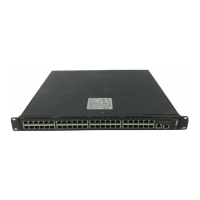Layer 2,3,IPv6+QoS Switch
_____________________________________________________________________________
Layer 2,3,IPv6+QoS Network Switch User Manual Version 0.1 Page: 818/970
This key will be included, in the clear, in the OSPF header of all packets sent on the
network. All routers on the network must be configured with the same key.
Encrypt - If you select 'Encrypt' you will be prompted to enter both an authentication
key and an authentication ID. Encryption uses the MD5 Message-Digest algorithm. All
routers on the network must be configured with the same key and ID.
Authentication Key - Enter the OSPF Authentication Key for the specified interface. If
you do not choose to use authentication you will not be prompted to enter a key. If you
choose 'simple' or 'encrypt' the key may be up to 16 octets long. The key value will only be
displayed if you are logged on with Read/Write privileges, otherwise it will be displayed as
asterisks.
Non-Configurable Data
IP Address - The IP Address of the router interface.
Link State - Indicates whether the RIP interface is up or down.
Bad Packets Received - The number of RIP response packets received by the RIP
process which were subsequently discarded for any reason.
Bad Routes Received - The number of routes, in valid RIP packets, which were ignored
for any reason (e.g. unknown address family, or invalid metric).
Updates Sent - The number of triggered RIP updates actually sent on this interface. This
explicitly does NOT include full updates sent containing new information.
Command Buttons
Configure Authentication - Display a new screen where you can select the
authentication method for the virtual link.
Submit - Send the updated configuration to the switch. Configuration changes take effect
immediately. These changes will not be retained across a power cycle unless a save is
performed

